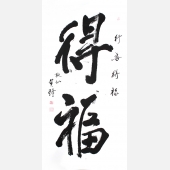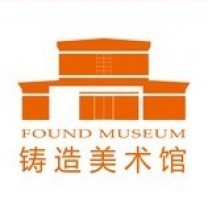- 资质:
- 评分:
1分 2分 3分 4分 5分 6分 7分 8分 9分 10分 9.8分
- 印象:
- 经营时间:17年
- 展厅面积:
- 地 区:北京-朝阳-一号地
再释抽象
2011-04-15 11:21:26
铸造艺术馆荣幸地持续推荐具备本土语言特征的抽象艺术家。瞿倩梅旅法多年,在巴黎深居简出,进行20多年的绘画创作,以巴黎的艺术氛围滋养内心的创作激情,以执着的艺术追求历练笔下的艺术作品,感悟中西文化的异同,体味其中的根基所在,从而把两种世界中的艺术精华凝练在作品中,创作出具备东方哲学思考的大抽象绘画作品。
瞿倩梅早期在家乡江浙一带从事中国画创作,那里灵秀的山水土壤滋养了她的艺术感受力,催生了她类似传统文人士大夫那种留恋山川、悟对神通的感知力与抽象认识自然的性情。由此,她的创作自然而然地走向平面、简率与抽象写意。
作为一位女性画家,她并不浅浅地留守于游山乐水的闲暇情结中。当中国1980年代中期的中国艺术界正在发生翻天覆地地巨变时,她没有局限在“85新潮”艺术运动的狂热激情中,而是抱着出国开阔眼界的想法,踏上旅法学艺的漫漫长路,这个选择增高了她的见地与视野。在巴黎,西方艺术的真实面貌可以尽收眼底,然而,中国的抽象艺术与西方本土的架上抽象艺术究竟有什么本质差异?在参观塔皮埃斯(Antonio Tapies 1923生于西班牙巴塞罗那,是当今西方画家里最具有东方哲学思想的绘画大师之一)的绘画展览之后,瞿倩梅更加深刻地反思了抽象艺术的去向问题。她逐渐放下国画的毛笔,在亚麻布上开拓独立的艺术空间。
她开始执着于对材质、媒介的研究,而后又从媒介本身深入对绘画形式的探索。但是,不同于国内80、90年代的“前卫”艺术家们的探索,瞿倩梅在法国安静地解决方寸画布与精神自由抒写的二者关系;探索抽象绘画作为一个独立而悠久的形式其存在的意义和创新的问题。从这个层面上说,她的绘画是思考型的、直指精神诉求的纯粹抽象绘画。然而,在她的抽象艺术中,蕴含着不能怯(祛)除的“东方哲学”意识。多年旅居法国的生活不能改变其民族思维习惯——心怀造化、澄怀味象、用绘画抒写心意是她一直秉持的东西。因此,瞿倩梅的作品即使在西方创作体系内游走,也始终彰显着东方艺术博大的胸怀与空灵变换的色彩。
在她的画面中,特殊材料的铺陈以及不规则的符号与隐蔽的形象都唤起观者对作品后面的逻辑与观念的好奇。扑面而来的材料厚度强化了你思考的动力。就好像你面对这个作品的时候,想象力立刻被激发出来进而去探索平日忽略的意识角落。这个读画的过程更像是一种“自我发掘”,而不是简单的欣赏——通过她绘画材料中的“物质”提示进入自己的潜意识领域进行感性与理性的对话——这便是中国古代绘画者的终极目的,况味抒怀、自然与内心融为一体。
瞿倩梅的绘画正是以这样饱满的激情与平和的心境与感受、去创作当下的大写意抽象绘画,这是当下人们共同需要的心理形态。
Then release abstraction
Found Art Museum is honored to continually recommend abstract artists who are provided with local linguistic features. Qu Qianmei has lived in France for years. While she lived in Paris, she was reclusive to pursue artistic creation in painting for more than twenty years with the artistic atmosphere in Paris nourishing inner creative passion and persistent artistic pursuit toughening her works. She experiences the similarities and differences between Chinese and Western cultures to taste their foundations. Thereby artistic essences lie in these two kinds of worlds are condensed in her huge abstract paintings which possess Eastern philosophy.
During her earlier stage of career, Qu Qianmei has devoted to Chinese paintings at her hometown among the area of Jiangsu and Zhejiang provinces, where delicately beautiful landscapes and soil nourished her artistic sensibility and gave birth to her temperament like traditional literati or scholar-bureacrats who linger about mountains and rivers while possessing perception of the supernatural as well as abstract understanding of the nature. As a result, her creations are naturally inclined to be plane, simple and abstract freehand works.
As a female artist in painting, she does not stay superficially in the leisurely complex of hiking tour. When Chinese artistic circle was undergoing radical changes in the mid-1980s, she was not limited in the fanatical passion of “85 New Wave” art movement but travelled to France for learning arts with the idea of holding broaden horizons abroad. This choice has increased her insight and vision. In Paris, the panoramic view on realistic features of Western art could be gotten, however, what’s on earth the essential difference between the Chinese abstract art and Western local abstract art on shelf? After she has visited the exhibition of Tapies (Born in 1923 in Barcelona, Spain, Antonio Tapies is one of western masters in painting who are provided with oriental philosophy.), Qu Qianmei more profoundly reflects on the directions of abstract art. She gradually puts down the brushes of traditional Chinese paintings while turns to explore her independent art space on linen.
She begins to cling to studies on materials and media and then continues her in-depth exploration in forms of painting through media itself. However, quite different from explorations which pursued by domestic “avant garde” artists who were born in 1980s and 1990s, Qu Qianmei quietly solved the relationship between linen and depiction of spiritual freedom in France; she also explored abstract paintings’ meaning of existence and its innovation as an independent long-standing form. From this perspective, her paintings are elaborative absolutely abstract paintings which direct to spiritual demands. Nevertheless, her abstract art contains unabated consciousness of “Oriental philosophy”. Years of life in France could not change her national habit of thinking—fortunes in her heart, mental realm and expression of intentions with paintings have been something upheld by her all the time. Therefore, even Qu Qianmei’s works wander among western systems of creation they still reveal profound bosom and ethereal changing colors of the Oriental Art.
In the general appearances of her paintings, the expatiation of special materials, irregular symbols and hidden figures all arouse audience’s curiosity for the logics and conception behind the works. Thickness of the materials directly reinforces your thinking power. Just as you face this work, your imagination is immediately inspired to explore sense corners usually neglected. This process of comprehension is more like a kind of “self-discover” rather than simple appreciation—by the “material” in her painting materials it prompt access to their subconscious mind for emotional and rational dialogue—this is the ultimate goal of Chinese ancient artists in paintings who combine nature and heart to be sensitive to the circumstances and express feelings.
Full of enthusiasm as well as in peaceful mood and experience which is the psychological form of common needs nowadays, Qu Qianmei’s works are created as abstract works of tremendous freehand.
上一篇:上海双年展艺术家逐一登场
下一篇:本周末精彩展览推荐

 黄琦
黄琦 武中奇
武中奇 测试用艺术
测试用艺术




